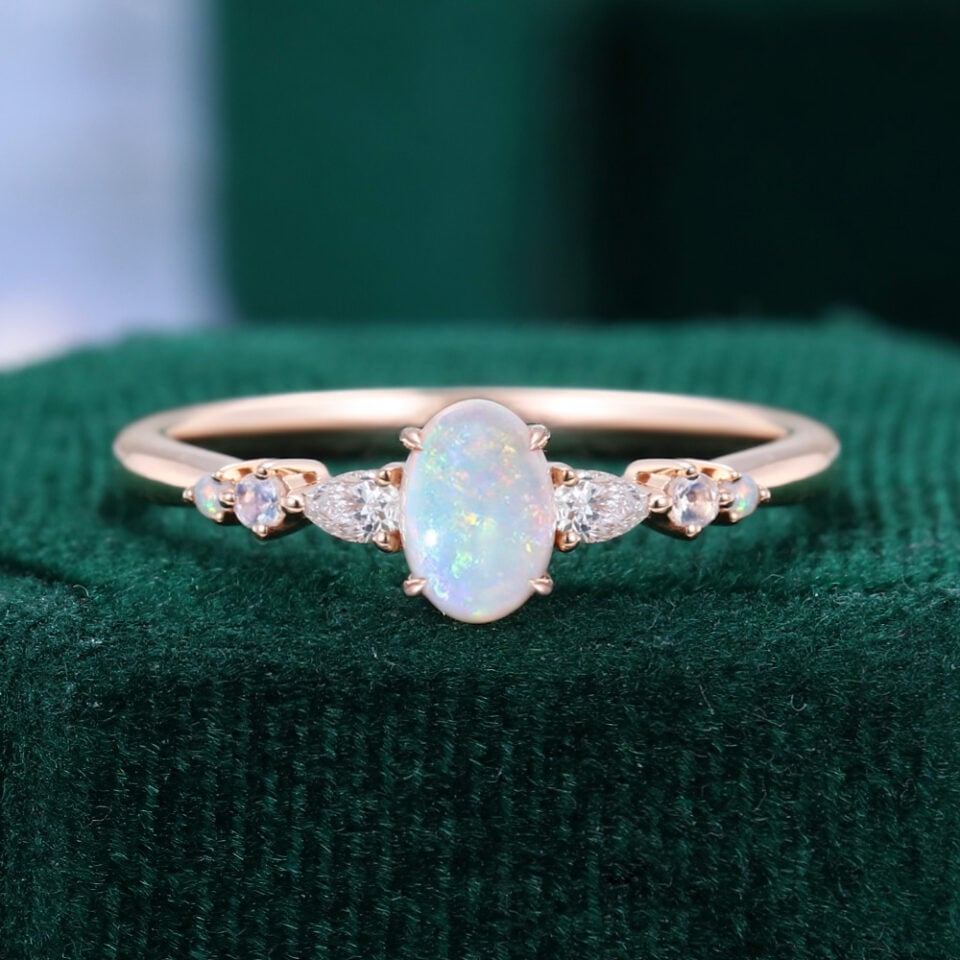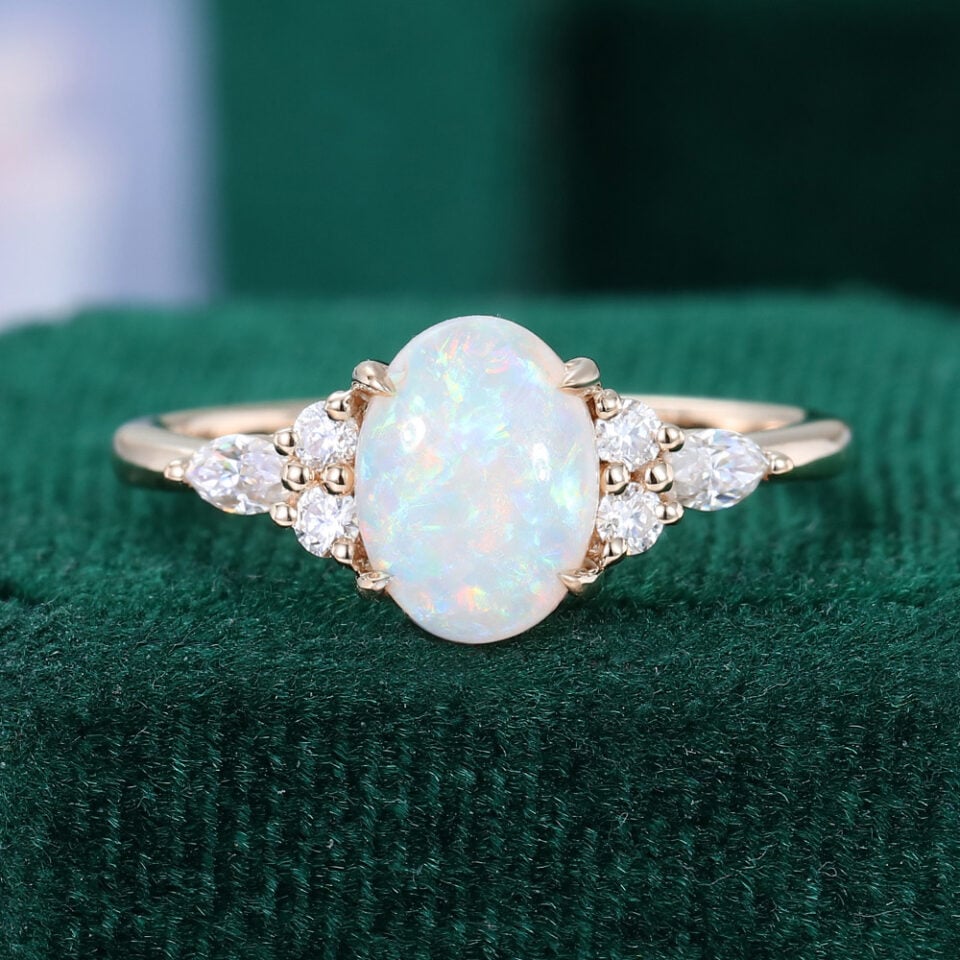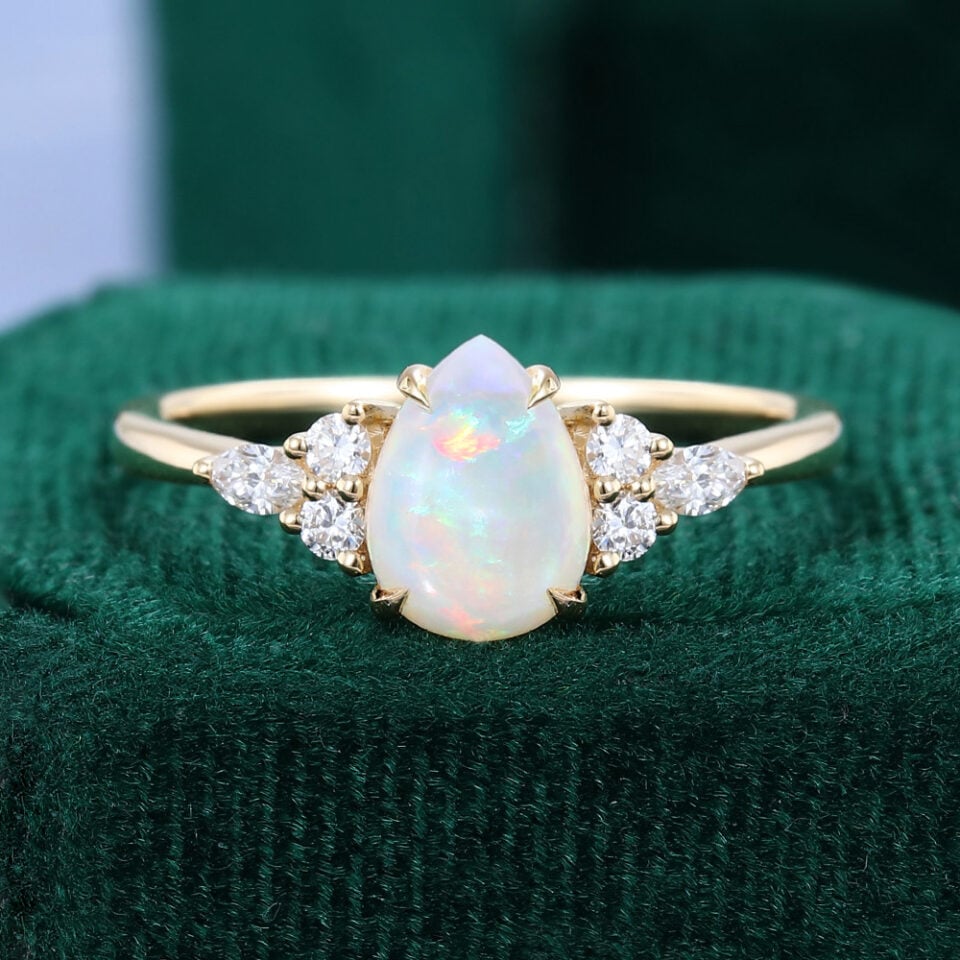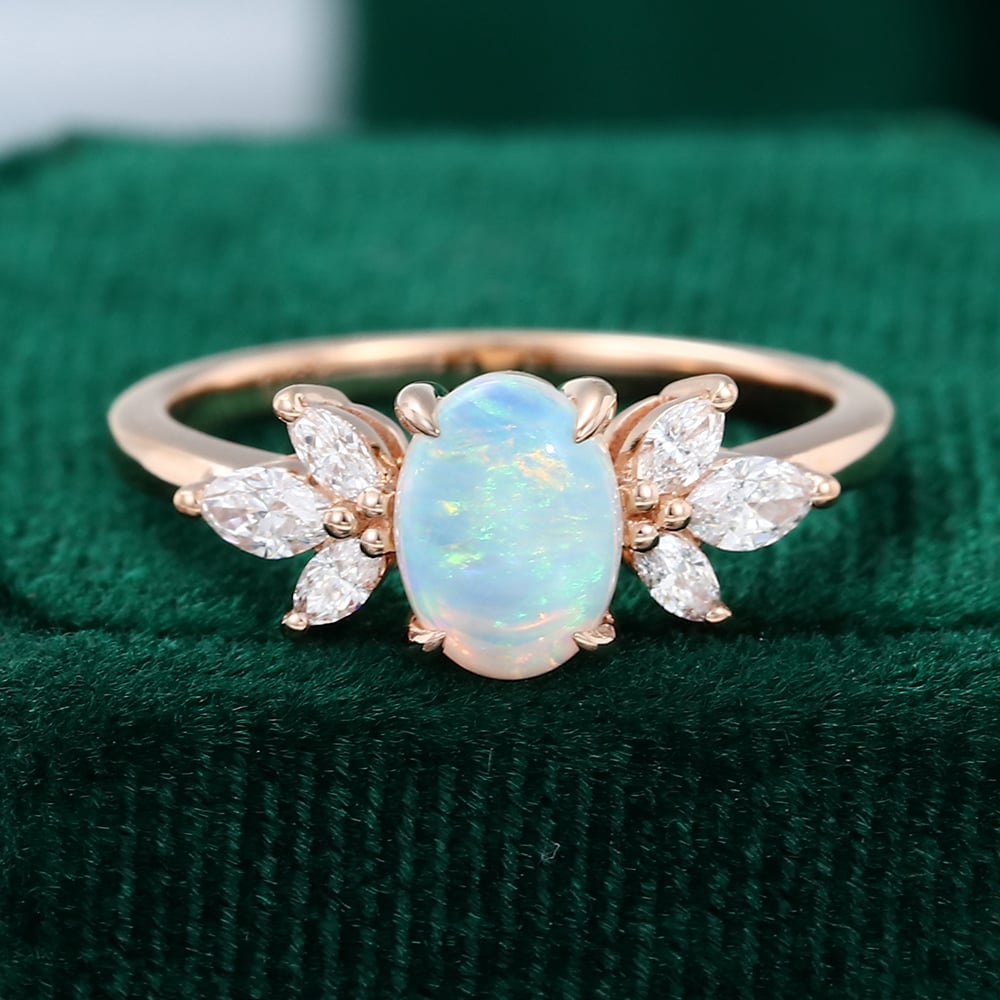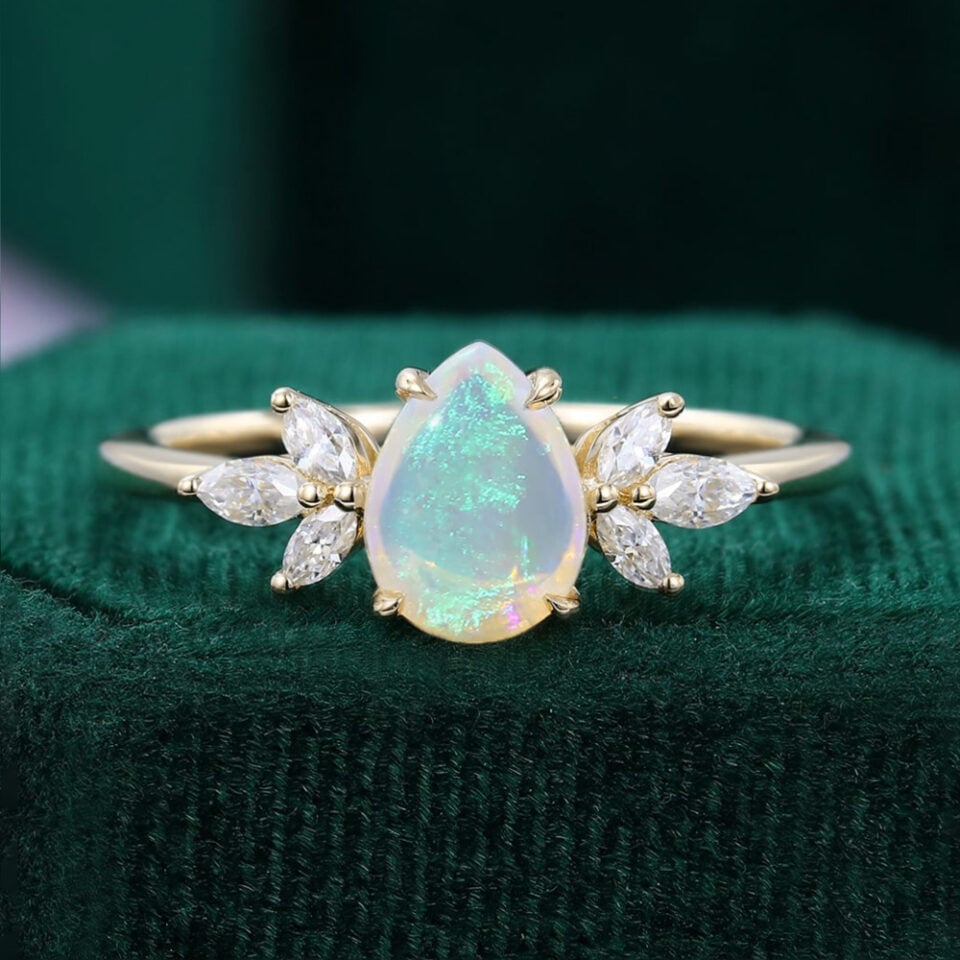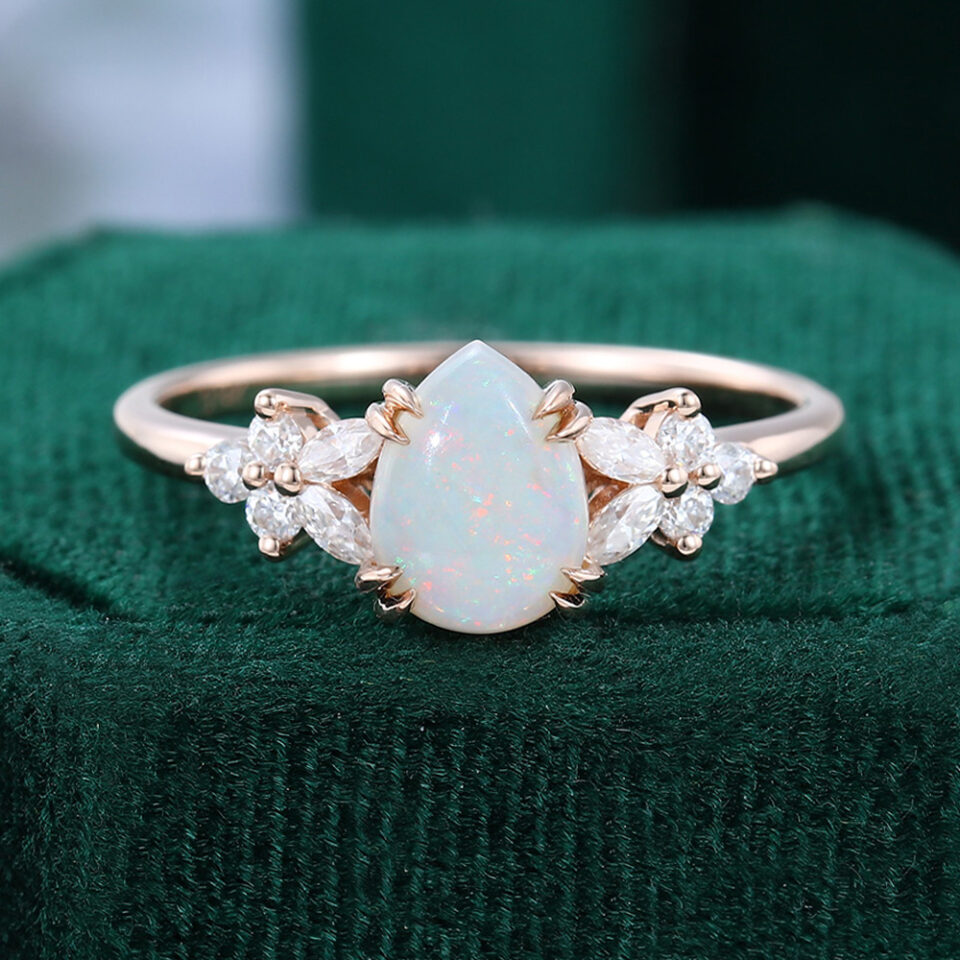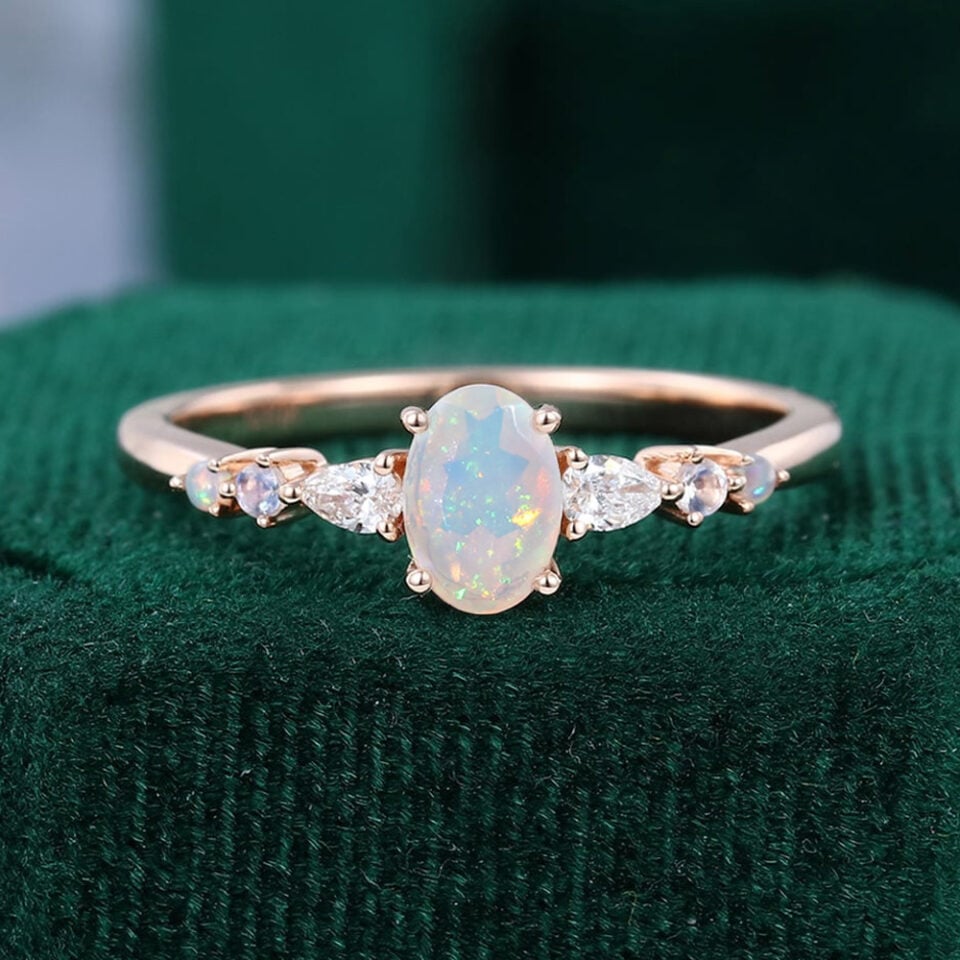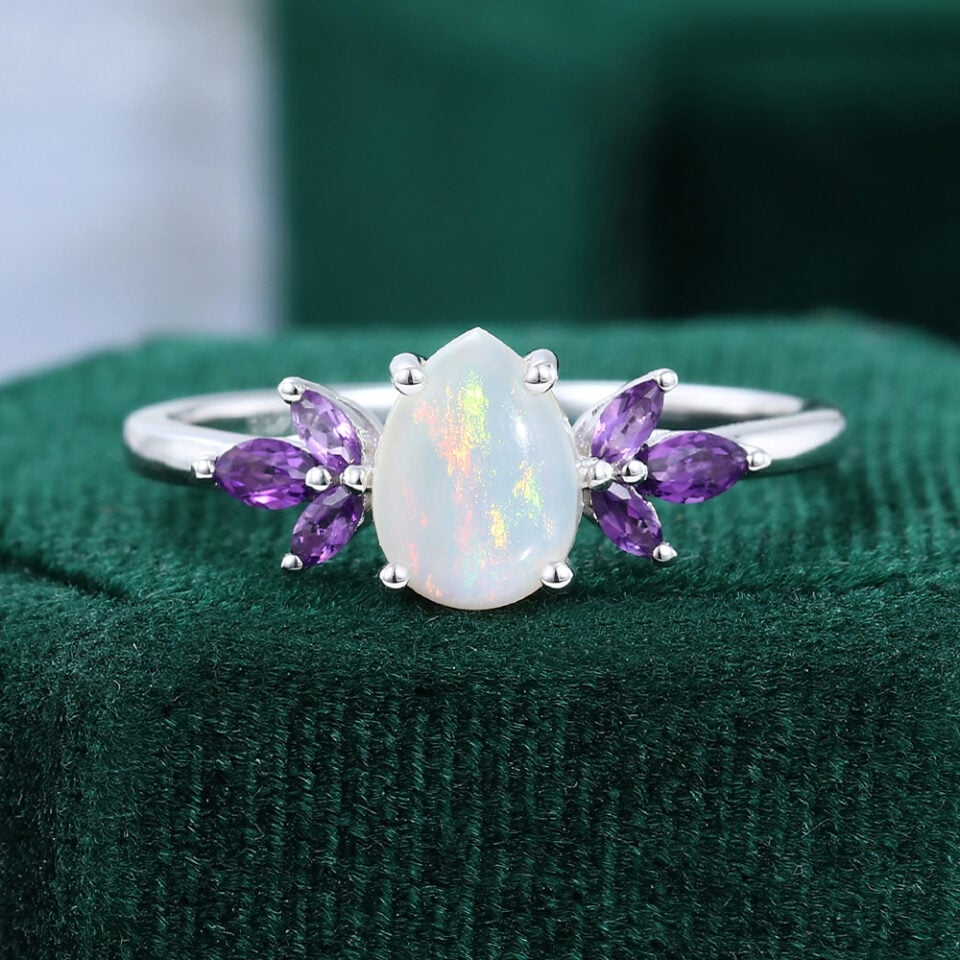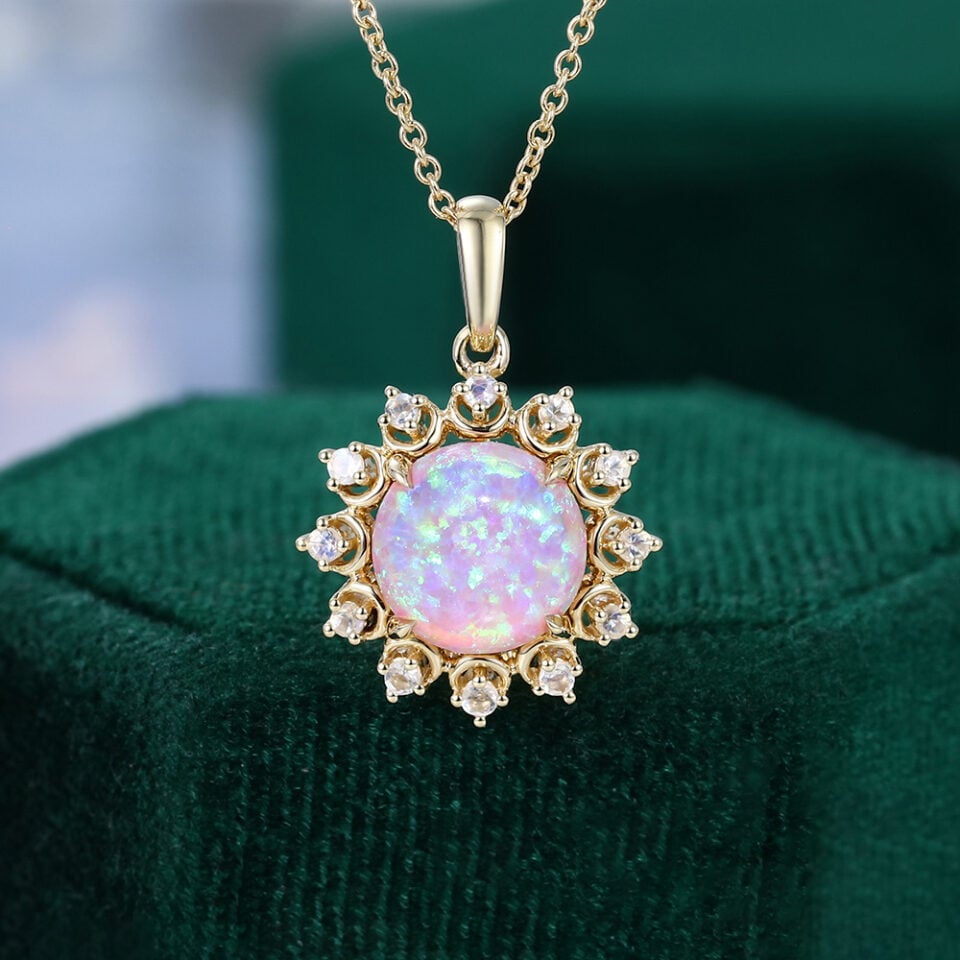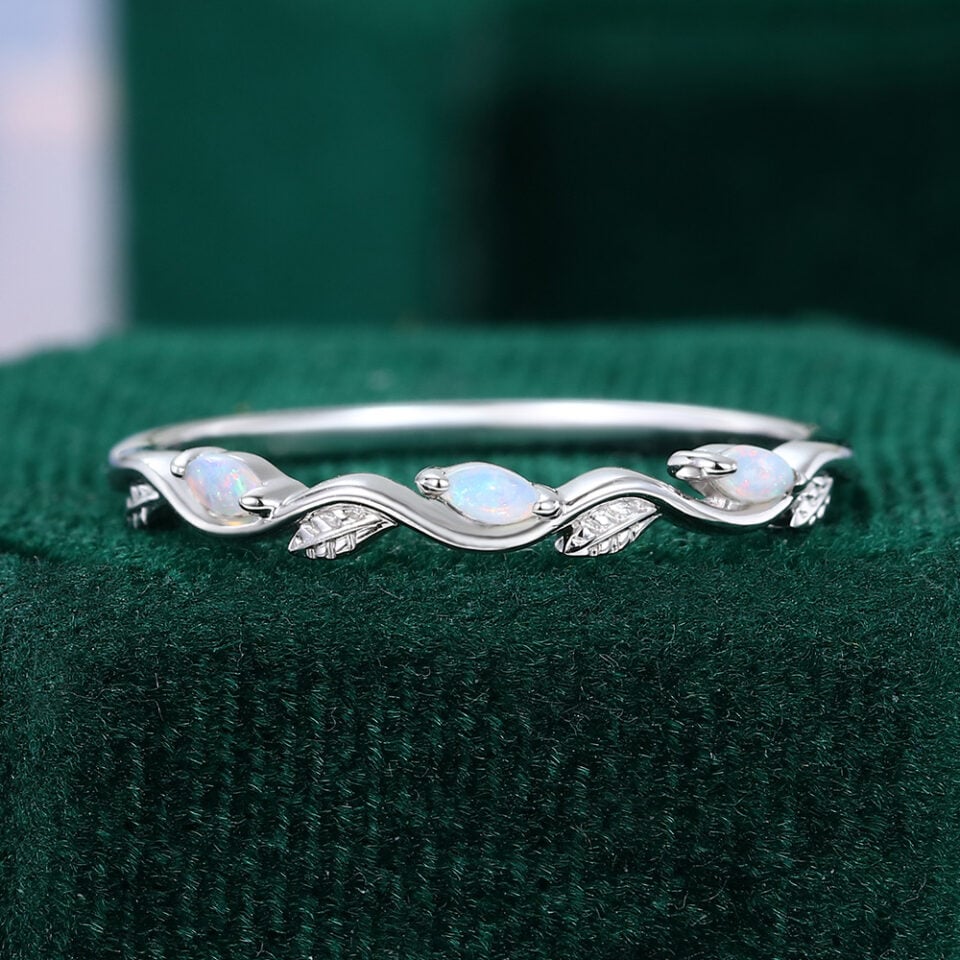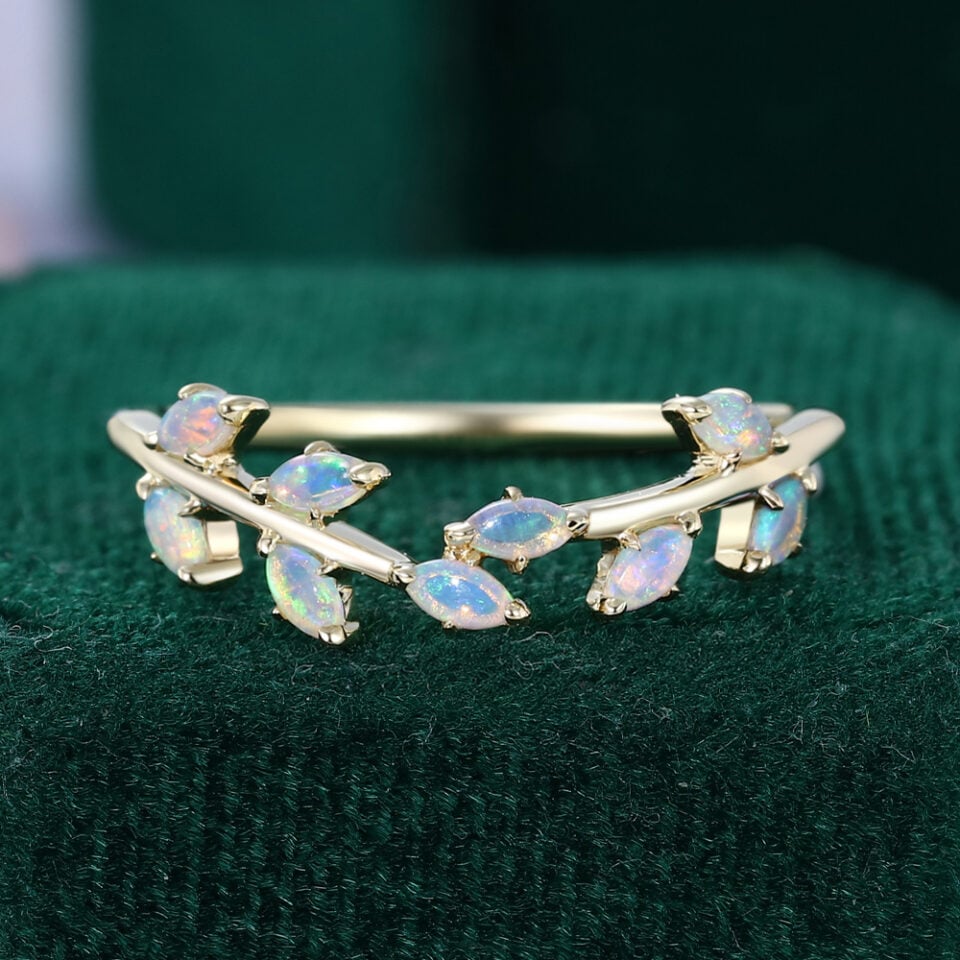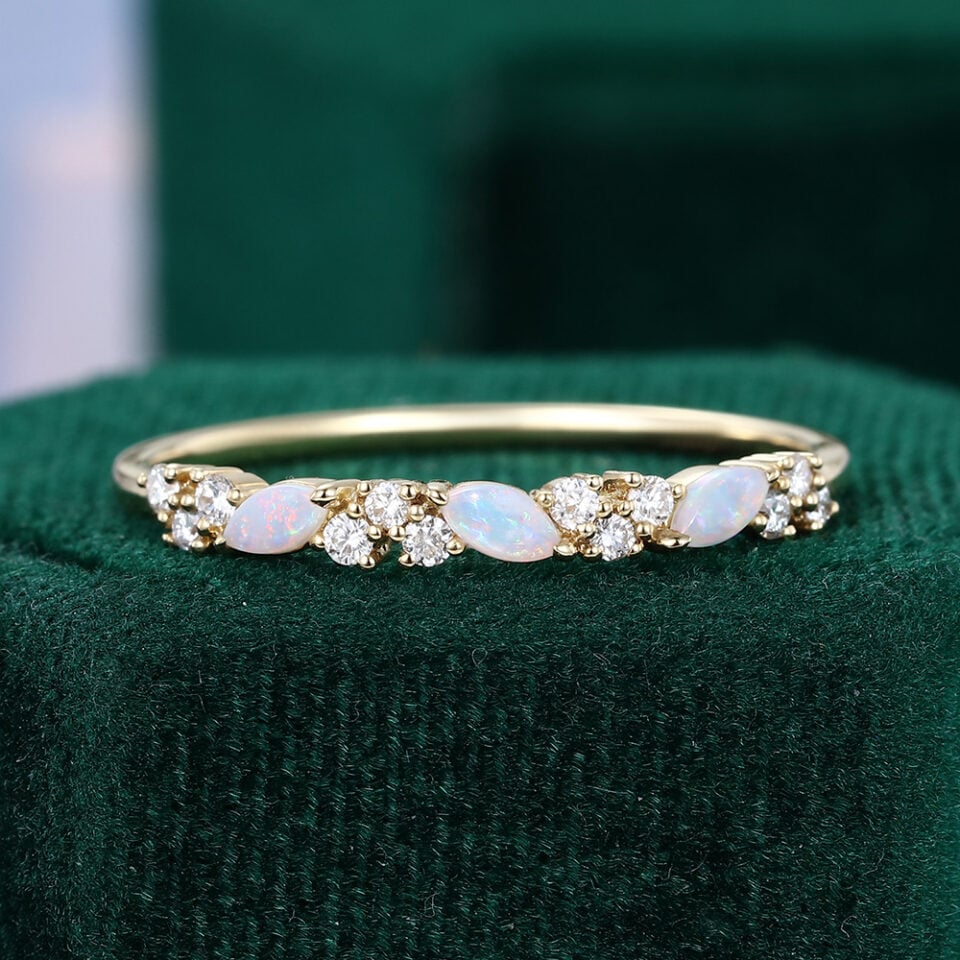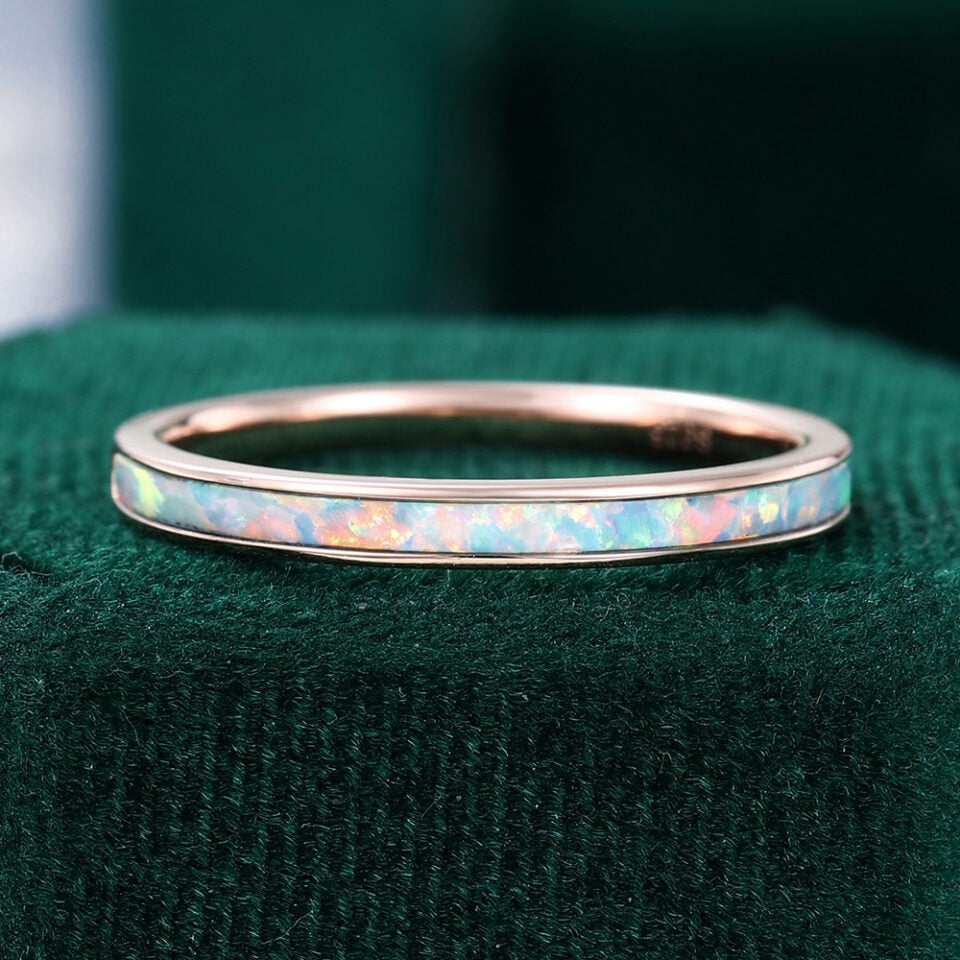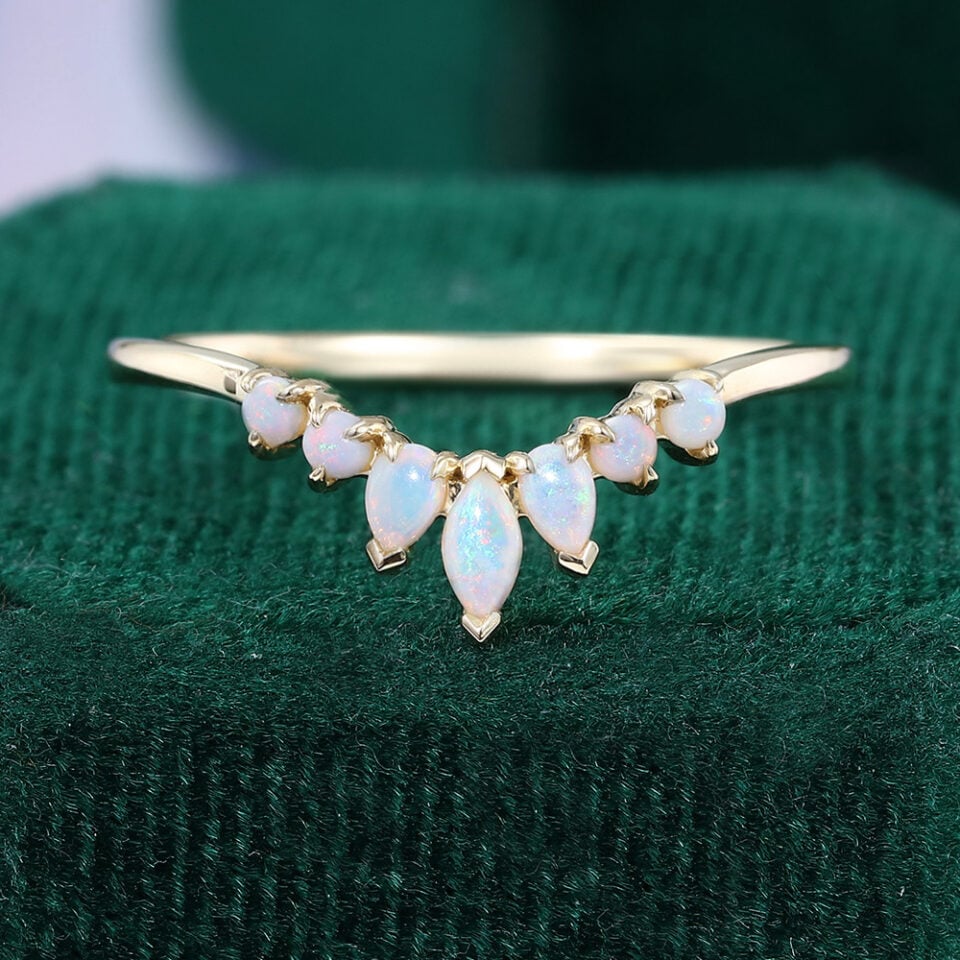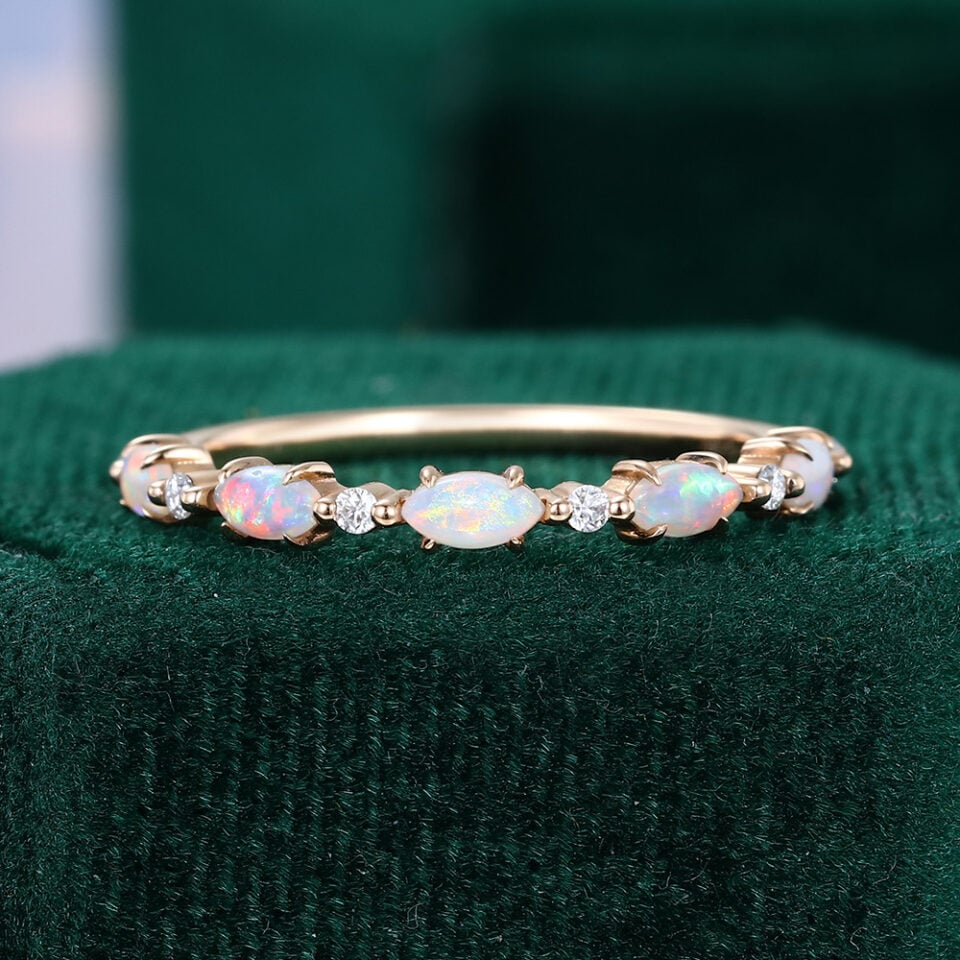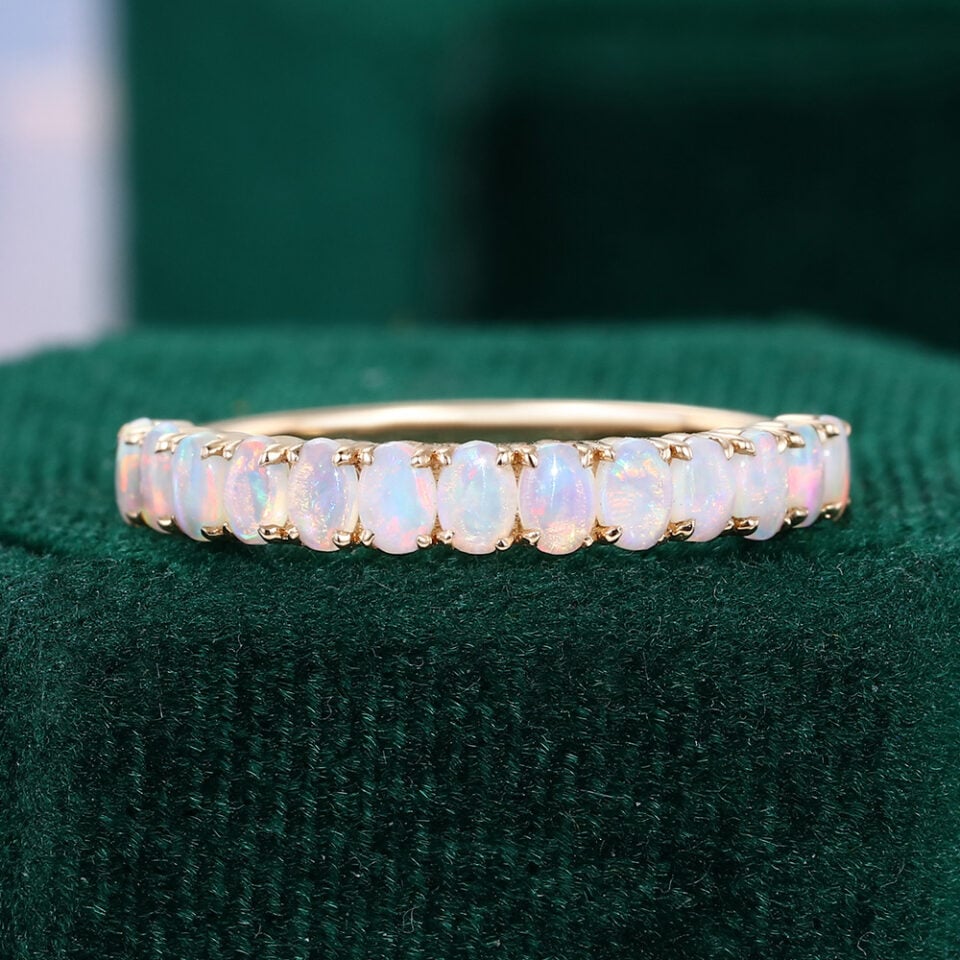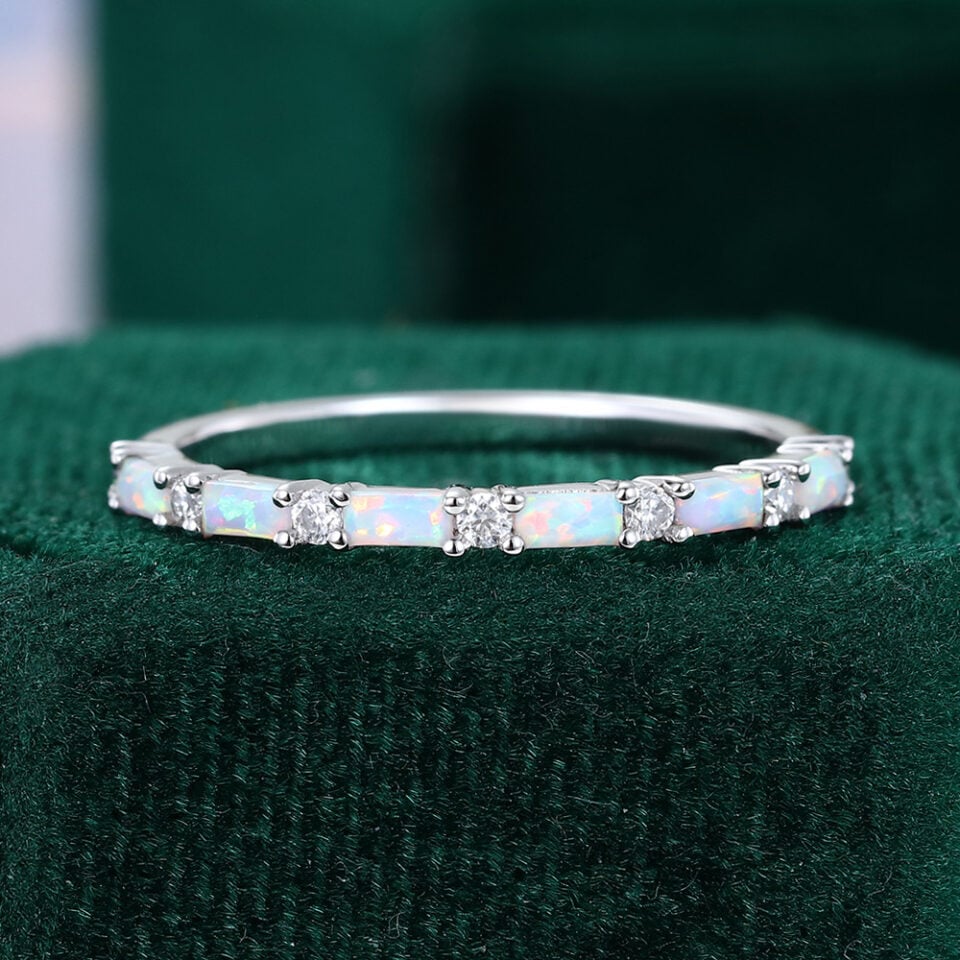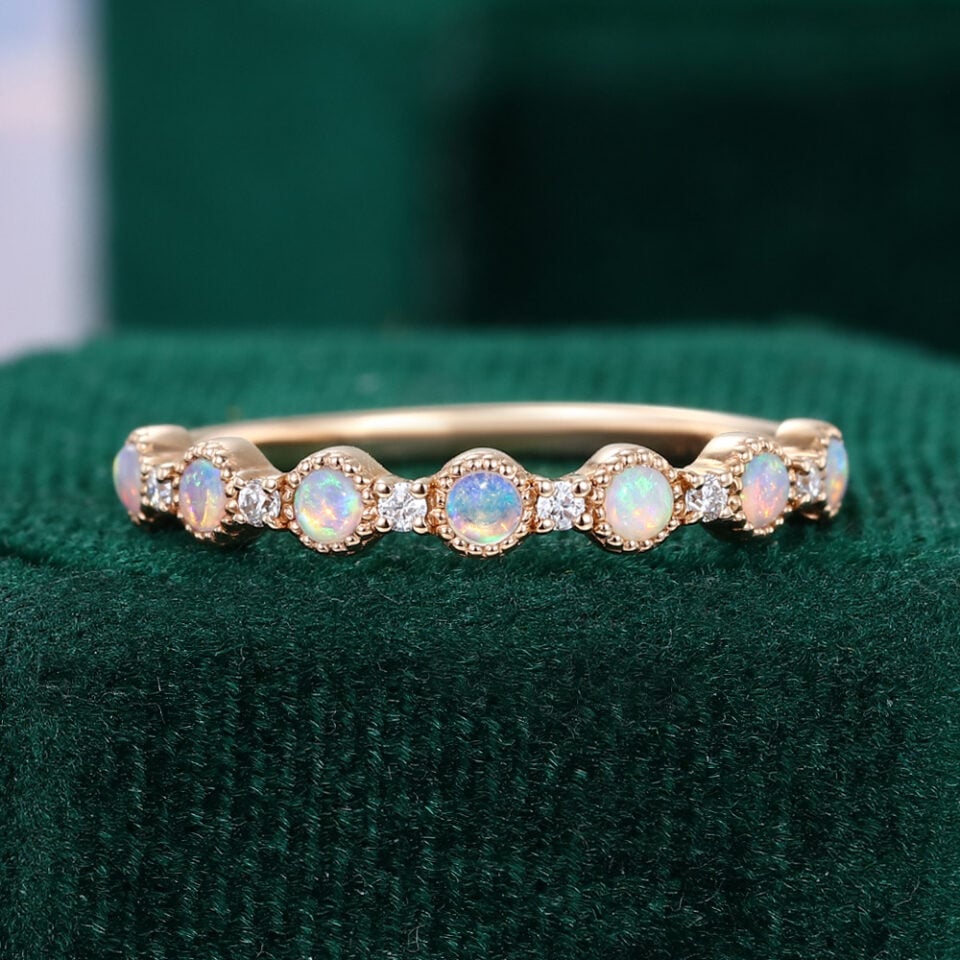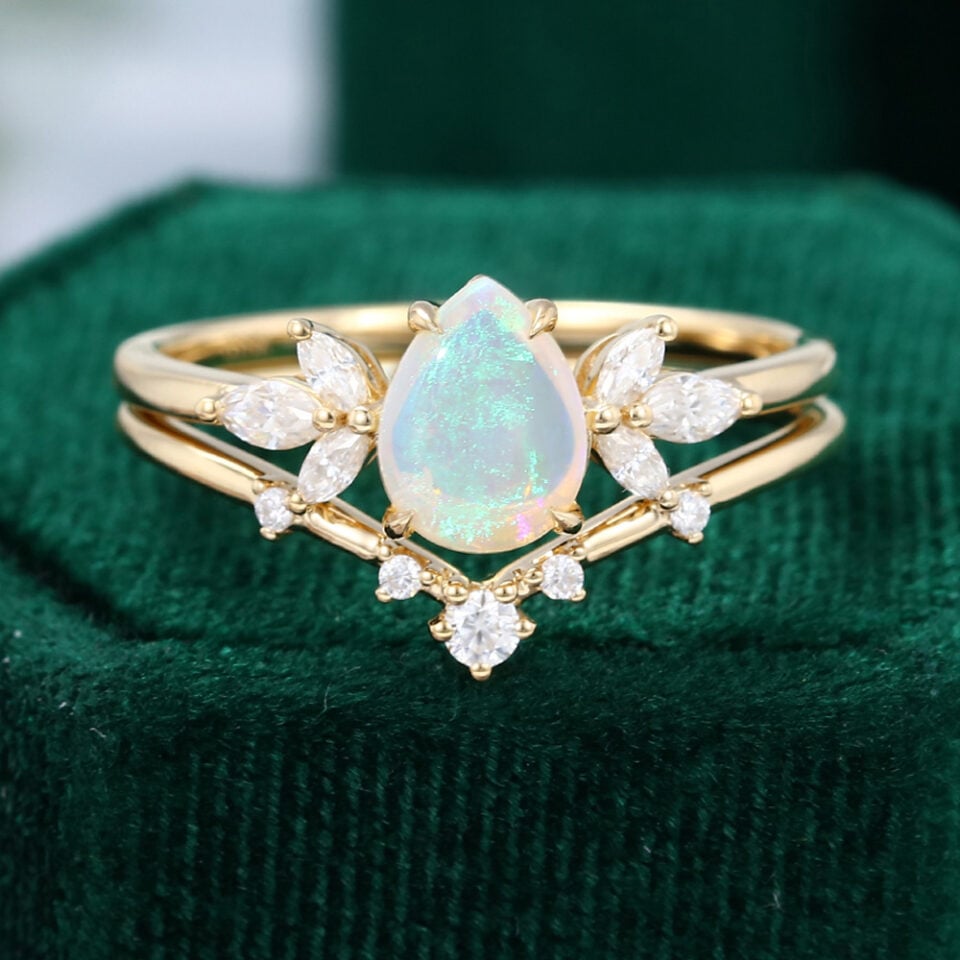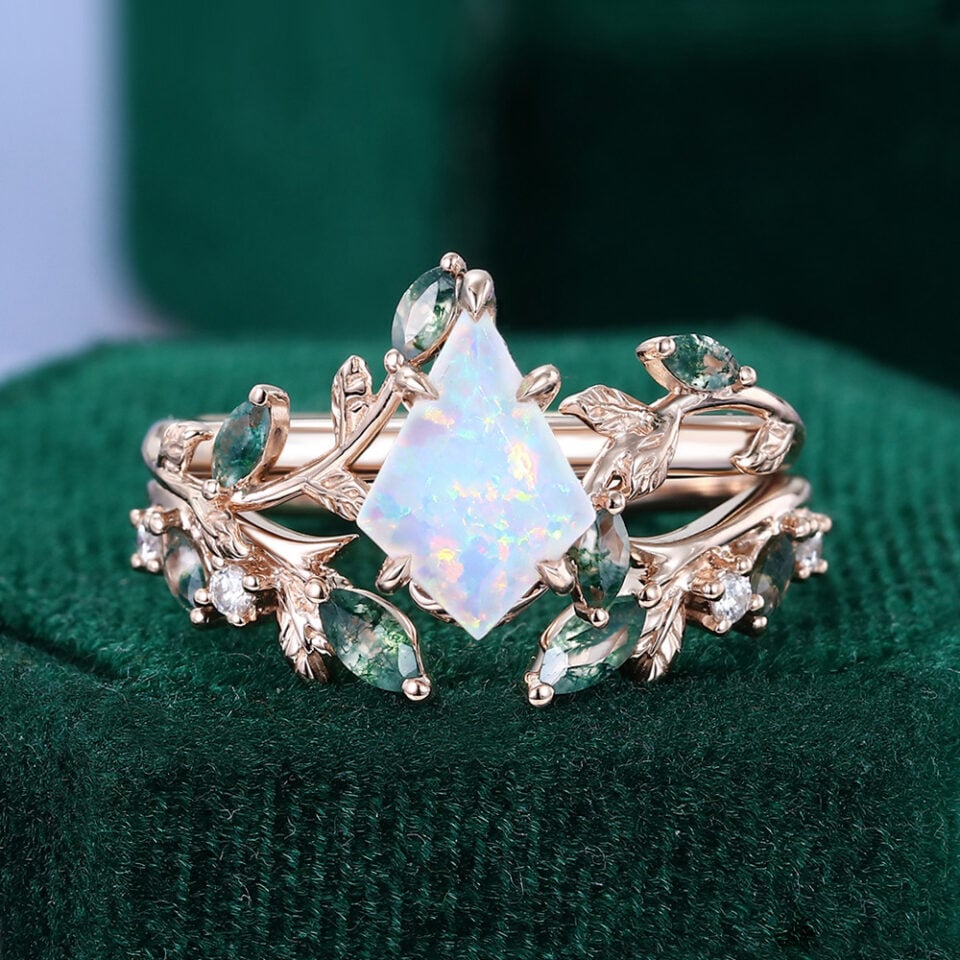- by MollyJewelryUS
- July 31, 2025
- Jewelry Care & Tips
Have you ever found yourself mesmerized by an opal’s rainbow shimmer? That magic is called “play of color,” and it’s what makes every opal unique and captivating. However, that luminous shimmer comes with a catch: opals require more care than the average gemstone. Their soft nature means common jewelry cleaning methods might not work and could cause lasting damage. To ensure your opal rings and other jewelry looks brilliant for years to come, it’s crucial to understand its characteristics and learn the proper cleaning, protection, and storage methods. This guide will walk you through everything you need to know to keep your opals looking brilliant.
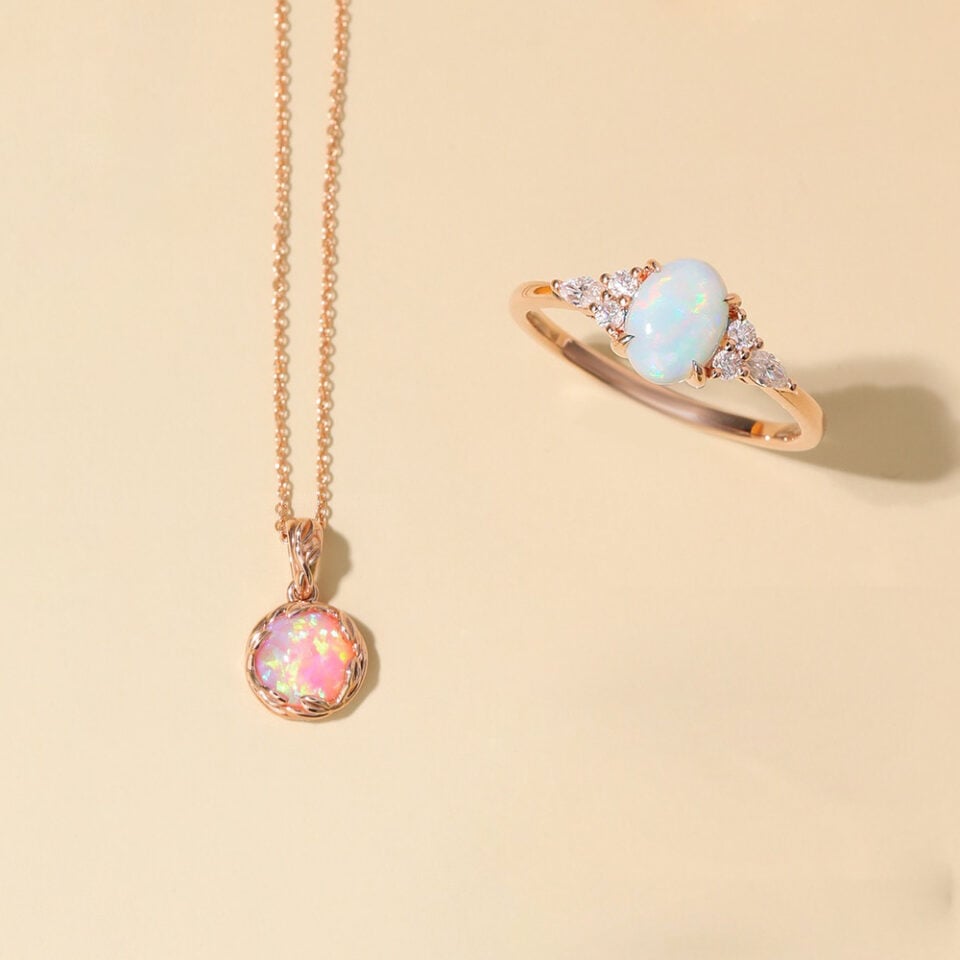
Table Of Contents:
- Know Your Opal Type
- How to Protect Your Opal Jewelry (Daily Wear Tips)
- How to Clean Your Opals (Without Causing Damage)
- How to Store Your Opal Jewelry
- Common Myths (and the Truth)
- When to Call in the Experts
- Table 1: Opal Types and Their Special Care Needs
- Table 2: Opal Care Quick Guide: Do’s and Don’ts
1. Know Your Opal Type (Because Not All Are the Same)
Not sure why your opal needs extra care compared to diamonds or sapphires? Let’s break down what makes this gem so unique—and yes, a bit more delicate.
Physical and Chemical Features
Opal’s beauty comes from its unique makeup:
- What it’s made of: Opal is basically a hardened gel of hydrated silica, which means it contains a certain amount of water. This is usually between 6-10%, but can be as high as 20% or even 3-21%, depending on the opal type and where it came from. These water molecules trapped inside the stone give opal its famous play-of-color. But this water content also makes it very sensitive to changes in its surroundings, which is why it’s delicate.
- Hardness: On the Mohs hardness scale, which measures how scratch-resistant a gem is, opals rank between 5.5 and 6.5. This is much lower than many other common gems like diamonds, sapphires, and emeralds. This lower hardness means opals can get scratched and worn down more easily.
- Structure: Precious opals have a tiny, organized structure made of three-dimensional, unorganized (amorphous) hydrated silica spheres with small gaps between them. This amorphous (non-crystal) structure means it doesn’t have a fixed crystal pattern, making it more likely to crack or break if hit.
Why Opals Need Special Care
These natural features of opals make them delicate to outside conditions:
- Easy to scratch: Because they are relatively soft, opals can be easily scratched by harder materials. Surprised? Even something as ordinary as dust can leave a mark on your opal—yes, really! This means even wiping it the wrong way can cause scratches.
- Sensitive to temperature changes: Opals are very sensitive to temperature changes. Sudden or big changes, like going from a cold outside to a hot sauna or hot tub, can make the water inside expand or shrink quickly. This internal stress can cause tiny cracks on or inside the gem, known as “crazing”.
- Risk of drying out: Opals need to keep their internal water content to stay stable and show their play-of-color. In very dry places, opals can slowly lose water, leading to drying out, which can cause crazing and make them change color or lose their shine.
- Easy to damage from impact: Opal’s toughness (how well it resists breaking or chipping) is rated as “poor to fair”. This means it’s more likely to chip or crack than many other gems if it’s hit or dropped. Opal engagement rings, especially, are more likely to get hit and worn down because they are worn every day.
Care Differences for Different Opal Types
How you care for an opal isn’t always the same; the type of opal (solid, doublet/triplet, or from different places) changes the specific care details.
- Solid Opals (Hydrophane & Non-Hydrophane)
- What they are: Solid opals are natural opal gemstones that are cut and polished from a single piece of opal, without any backing or protective layers. In terms of care, they can be broadly categorized into two types: hydrophane and non-hydrophane opals. *Note: all opals used at MollyJewelryUS’ pieces are solid opals, buyt we use both hydrophane and non-hydrophane ones, and we label “Ethiopian Opal” if it’s hydrophane opal.
- Hydrophane Opals: These include varieties like crystal opal and hydrophane opal, often found in Ethiopia’s Welo region. Hydrophane opals are known for their water-absorbent nature—when exposed to moisture, they can temporarily become more transparent or change color. In some cases, absorbed impurities may lead to permanent discoloration or damage, so extra care is needed.
- Non-Hydrophane Opals: Most solid opals fall into this category, including white opal, black opal, fire opal, and pink opal. These are typically sourced from Australia, Brazil, and Mexico. Non-hydrophane opals are generally considered non-porous and stable—they do not absorb water or other liquids, as their internal moisture is locked in during formation.
- Care:
- Non-Hydrophane Opals: Safe to clean with warm soapy water and a soft brush or cloth. Avoid ultrasonic or steam cleaning. Store in a soft pouch, and in very dry climates, consider sealing them with a damp cotton ball to prevent crazing.
- Hydrophane Opals: Avoid water or any liquids entirely. Clean only with a dry, soft cloth. Store in a cool, dry place, away from humidity or extreme temperature shifts. Do not wear while washing hands, swimming, or applying lotions.
- How to Tell: One simple test is to place a small drop of water on the surface. If it absorbs quickly, it’s likely a hydrophane opal. When in doubt, it’s best to treat your opal as if it is hydrophane to ensure safer care and handling.
- What they are: Solid opals are natural opal gemstones that are cut and polished from a single piece of opal, without any backing or protective layers. In terms of care, they can be broadly categorized into two types: hydrophane and non-hydrophane opals. *Note: all opals used at MollyJewelryUS’ pieces are solid opals, buyt we use both hydrophane and non-hydrophane ones, and we label “Ethiopian Opal” if it’s hydrophane opal.
- Assembled Opals (Doublets and Triplets):
- Doublets: These are made of a thin slice of natural opal glued to a dark backing (often black onyx, obsidian, or common opal) to make the opal’s color look stronger.
- Triplets: These are like doublets but have an added clear top layer (usually quartz or glass) to protect the opal and give it a rounder shape and more shine.
- Features: The layers of assembled opals are held together with water-soluble or partly water-soluble glue.
- Care: Never soak them in water. Long exposure to water can make the glue break down, causing the layers to separate and the opal to look blurry, gray, or cloudy. You should even take off assembled opal jewelry when washing hands, showering, swimming, or washing dishes.
Related: Types Of Solid Opal
Table 1: Opal Types and Their Special Care Needs
| Opal Type | Cleaning Advice | Storage Advice | Wearing Tips |
|---|---|---|---|
| Non-Hydrophane Opals | Mild soapy water, soft brush or cloth, rinse gently | Store separately; sealed bag with damp cotton in dry climates | Avoid strong impact and sudden temperature shifts |
| Hydrophane Opals | Dry cloth only; no water or cleaners | Cool, dry environment; avoid moisture and freezing temperatures | Avoid water, oils, lotions, and drastic temperature changes |
| Doublet Opal | Wipe gently with damp cloth; never soak or rinse | Same as solid opals; keep away from heat or high humidity | Remove before any water exposure |
| Triplet Opal | Wipe gently with damp cloth; never soak or rinse | Store in a dry, padded space away from temperature extremes | Remove before washing, swimming, or using personal care products |
2. Daily Wear: How to Protect Your Opal Jewelry
Let’s be real: life happens. But opals don’t love rough treatment. Here’s how to wear them with confidence while avoiding common mishaps:
Avoiding Physical Damage
Opals are not very tough and can chip easily. We get it—life gets busy. But before you start gardening, washing dishes, or heading to the gym, it’s worth giving your opal a little break. A few seconds to remove it can save you from heartache later. This includes:
- Rough activities: During sports, gardening, or heavy work, opals can easily get hit, scratched, or pressed.
- Household chores: Especially washing dishes, to prevent opal rings from hitting sinks, dishes, or other hard objects, or being exposed to cleaning products for too long.
- Any activity that might cause impact or rubbing: Even everyday tasks like typing or cooking can put opal rings at risk.
- Handle with care: Opals are soft and can chip easily, so always handle them gently when putting them on or taking them off. Avoid dropping or bumping them.
- Rings are especially delicate: Opal rings are very likely to get hit and worn down because they are always exposed during daily activities.
Choosing Protective Settings
The way an opal is set greatly affects how durable it is. For a delicate gem like opal, the best protection isn’t just about care after wearing; it should be thought about from the moment you buy or design it.
- Bezel Settings: These are considered the safest and most recommended way to set opals. In this setting, a metal edge is hammered over and completely wraps around the gem’s edge, giving the opal full protection. This greatly lowers the risk of chipping, scratching, and falling out. While bezel settings usually use more metal and might cost more, the safety they offer is a worthwhile long-term investment. This “preventive design” idea makes sure that beauty and usefulness go hand-in-hand, allowing the jewelry to fit better into your daily life.
- Claw Settings: Claw settings (usually four or six prongs) can also hold opals securely and show off the gem as much as possible, letting light in from all angles. However, compared to bezel settings, claw settings offer less protection for the opal’s edges, making it more likely to get damaged from side impacts. For opals, the prongs in a claw setting should be thick enough to be secure, and it’s best to avoid designs with sharp points or parts that stick out too much.
- Earrings and Necklaces: Even for earrings and necklaces, make sure the backings and clasps are strong and secure to prevent accidental drops and damage to the gem.
3. How to Clean Your Opals (Without Causing Damage)
Ever wondered why your opal ring looks a little cloudy? Don’t worry—we’ve got your back. With the right cleaning tips, your opal can sparkle like new again.
Safe and Effective Cleaning Methods
- Prepare cleaning solution: In a bowl, mix warm water (important: it must be warm, not hot or cold, to avoid sudden temperature changes) with a few drops of mild soap (like gentle dish soap or a special jewelry cleaner).
- Gentle cleaning: Dip a soft, lint-free cloth (like a microfiber cloth) or a very soft brush (like a baby toothbrush) into the soapy water and gently wipe the opal’s surface. When cleaning, focus on the gem’s edges and the setting, but avoid scrubbing hard to prevent scratching the opal’s soft surface.
- Rinse: Rinse the opal thoroughly with warm water to remove all soap residue. Again, make sure the water temperature is moderate; avoid using water that’s too hot or too cold.
- Dry: Gently pat the opal dry with a soft, clean cloth; do not rub or wipe hard. Let the opal air dry completely before wearing or storing it.
- Special cleaners: There are also jewelry cleaners made specifically for opals that you can consider using.
- Please note: Ethiopian natural opal may lose their color if soaked in water for a long time.
Cleaning Methods to Avoid
- Ultrasonic or steam cleaners: Never use these. This is one of the most common mistakes in opal care. The strong vibrations from ultrasonic cleaners and the high heat from steam cleaners can cause lasting damage to the opal’s delicate inner structure, leading to cracks or “crazing,” and can even break down the glue layers in assembled opals. While there might be a few exceptions, most trusted and experienced sources strongly advise against using ultrasonic cleaning for any opal. The main reason is that opal’s internal structure (hydrated silica gel) is very sensitive to vibrations and heat. Even solid opals can develop tiny cracks due to internal stress. For assembled opals, the glue layer is clearly fragile. So, as expert advice, it’s best to take the safest approach and completely avoid ultrasonic cleaners.
- Soaking assembled opals (doublets or triplets): Assembled opals should never be soaked in water because long exposure to moisture will make the glue between layers break down, causing them to separate and look cloudy or lose their shine.
- Harsh chemicals: Avoid exposing opals to any household chemicals, especially strong acids, bleach, chlorine, oven cleaners, or abrasive cleaners. These can damage the gem’s surface or the metal setting. Also, avoid direct contact with cosmetics like perfume, hairspray, and lotions; it’s best to apply these before putting on your jewelry.
- Abrasive materials and tools: Do not use any abrasive cleaners, stiff brushes, paper towels, or rough fabrics to clean opals, as they can easily scratch the opal’s delicate surface.
Cleaning Advice for Different Opals
- Solid Opals (Non-Hydrophane): Can be cleaned with warm soapy water and a soft cloth/brush, then rinsed thoroughly with warm water. Although some sources say solid opals can be soaked for a short time, for maximum safety, most experts advise against long soaking.
- Solid Opals (Hydrophane): It’s generally advised to avoid getting hydrophane opals wet. If cleaning is needed, simply wipe gently with a soft linen cloth.
- Assembled Opals (Doublets and Triplets): Because the glue layer is delicate, only wipe the surface gently with a damp soft cloth. Never soak or rinse to prevent damage to the glue layer.
4. How to Store Your Opal Jewelry
Proper storage is crucial for protecting opals from environmental factors and physical damage. Careful storage can prevent many common opal damage issues.
Think of your opals as little divas—they like attention and a bit of pampering when not being worn.
Store Separately
Opals are relatively soft (5.5-6.5 hardness) and can easily be scratched by other harder jewelry (like diamonds or sapphires). To avoid this type of damage:
- Always store your opal jewelry separately in a soft cloth bag, a lined jewelry box, or a jewelry box with individual compartments to prevent contact and rubbing with other jewelry.
- Keep the storage area dust-free, as dust particles (about 7.5 on the Mohs scale) can be harder than opal and might cause scratches when wiped.
Humidity and Temperature Considerations
Opal’s sensitivity to humidity and temperature is central to its care.
- Avoid extreme temperatures: Opals are very sensitive to temperature changes. Avoid exposing them to extreme heat (like direct sunlight, near heaters, stoves, saunas, hot tubs) or extreme cold (like freezing conditions). Big temperature swings can cause the water inside the opal to expand or shrink quickly, leading to irreversible crazing.
- Maintain proper humidity: Opals need to keep their internal water content to prevent drying out and crazing. The key here isn’t to make the opal “absorb” water, but to stop it from “losing” water. For solid opals, their internal water is fixed, but being in a very dry place for a long time (like a safe) can cause internal water to evaporate, leading to crazing.
- In very dry places (like safes or dry climates), you might consider storing opal jewelry with a damp cotton ball or damp cloth in a sealed plastic bag. This doesn’t make the opal “absorb” water, but creates a slightly moist environment to slow down the excessive loss of its internal water, preventing crazing.
- Some jewelers put a glass of water in their display cases to keep humidity levels up, which works on a similar idea.
- Avoid long exposure to strong light: While strong light itself won’t harm opals, long exposure to very hot, strong light can raise the temperature, leading to crazing. When storing, choose a cool place away from direct sunlight.
5. Common Opal Care Myths Debunked
There are many myths about opal care, and these misunderstandings can lead to improper care and even damage your precious jewelry. The widespread nature of these myths shows a tendency to generalize and rely on personal experience rather than scientific facts or expert advice. Today, we will clear up these myths one by one, helping you think critically and tell reliable information from unreliable sources.
Myth 1: Opals need to be soaked in water regularly to prevent cracking.
Fact: For Non-hydrophane opals, this is false. They are non-porous and don’t soak up water, so soaking them won’t make them last longer or look better. Wetting an already cracked stone will only temporarily hide the cracks but won’t fix the damage. However, for assembled opals (doublets/triplets) and hydrophane opals, you should absolutely not get them wet, as water can damage their glue layers or cause discoloration. This myth mainly comes from mistakenly applying the care needs of assembled opals to all opals.
Myth 2: Opals are very fragile and break easily.
Fact: Opals are indeed more delicate than most gems (like diamonds, sapphires), but they are not “extremely fragile”. As long as you avoid hard impacts, rough activities, and choose proper protective settings, opals can be quite durable. Also, some types of opals, like those with a low dome shape (“low cabochon”) and Boulder Opals, are generally stronger than thin slices of opal.
Myth 3: You need to rub opals with oil (like baby oil or olive oil) or glycerin to prevent cracking.
Fact: This will only make the opal’s surface oily and won’t do anything to prevent cracking. Non-hydrophane opals are non-porous and won’t soak up oil.
Myth 4: Opals are unstable and crack easily.
Fact: Most opals are very stable and don’t crack. Unstable material usually cracks soon after being mined (often after leaving the mine area) and is removed during processing and cutting. So, the finished opal you buy has usually passed stability tests.
Myth 5: Strong light will dry out opals.
Fact: Strong light itself will only make the opal look brighter and enhance its play-of-color. But be careful of very hot light sources; extreme heat can cause opals to expand and crack. So, avoid leaving opals under very hot lights or in direct sunlight for long periods.
Myth 6: Wiping opals with chemicals or cleaners will damage or discolor them.
Fact: Most mild oils, detergents, and common household items won’t damage opals. However, it’s still strongly advised to avoid harsh chemicals like bleach, chlorine, oven cleaners, and other strong corrosive substances, as these can harm the gem’s surface or the metal setting.
Myth 7: Wetting an opal can bring back its shine.
Fact: Wetting the gem will only make it look better temporarily because the water film will increase its transparency or hide surface flaws, but it won’t truly restore its shine. The only real way to restore the shine of an old gem is to have it professionally polished.
Myth 8: Flying to high altitudes will cause opals to crack.
Fact: High altitude or changes in air pressure won’t affect opals. Only impact, extreme temperature changes (like direct flame), or very low humidity for long periods will cause damage.
6. When to Seek Professional Help
While daily care is important, some situations require a professional jeweler or gem expert to ensure your opal jewelry is properly maintained and repaired. Professional care isn’t just an “optional service”; it’s an “investment” in your jewelry’s value. Regular professional checks and timely repairs can prevent small problems from becoming big ones, saving you from more expensive replacement costs and extending the overall life and beauty of your opal jewelry.
Regular Checks and Maintenance
- Suggested frequency: It’s recommended to take your opal jewelry to a trusted professional jeweler for a check-up every six months.
- What they check: The jeweler will carefully check if the setting is loose, if the gem has any damage (like tiny cracks, wear, or scratches), and assess its overall condition. Catching problems early can effectively prevent small issues from turning into major damage.
Professional Cleaning
- Deep cleaning: If your opal jewelry has stubborn dirt or has lost its original shine, a professional jeweler can use safe and effective methods for deep cleaning and polishing. They have the right tools and skills to safely bring back the opal’s original shine and brightness without damaging it.
Repairing Damage
- Scratches or dullness: Long-term wear can cause tiny scratches on the opal’s surface or make it lose its original shine. Professional repolishing can effectively remove these surface flaws, making it look new again.
- Crazing or cracks: If your opal shows crazing or clear cracks, it’s best to get help from a professional gem expert right away. While some minor crazing from drying out might temporarily improve with professional rehydration, serious damage is often permanent and might require replacing the gem.
- Setting repairs: Professional jewelers can fix or replace loose, worn, or damaged settings, making sure the opal is secure and won’t fall out or get further damaged.
- Assembled opal issues: If a doublet or triplet opal becomes cloudy or separates due to water getting in, it’s usually hard to fix. In these cases, the most common solution is to replace the stone.
7. Conclusion: Cherish Your Opal, Pass It Down Through Generations
Opals, with their amazing play-of-color, are true treasures in the world of jewelry. Even though their delicate nature means they need extra care, by following the right cleaning, wearing, and storage tips, your opal jewelry can keep its unique sparkle for a long time.
Understanding the type of opal you have is very important, as non-hydrophane opals, assembled opals, and hydrophane opals each have their own special care needs. By avoiding extreme temperatures, physical impacts, and wrong cleaning methods, and by getting help from a professional jeweler regularly, you can cherish this gift from nature and pass it down as a precious family heirloom for generations.
Table 2: Opal Care Quick Guide: Do’s and Don’ts
| Do’s | Don’ts |
| Clean with mild soapy water and a soft cloth/brush. | Use ultrasonic or steam cleaners. |
| Gently pat dry with a soft cloth and let it air dry. | Soak assembled opals (doublets/triplets). |
| Store opal jewelry separately in a soft bag or lined jewelry box. | Expose opals to extreme temperatures (too hot or too cold). |
| In dry places, store with a damp cotton ball in a sealed bag. | Expose opals to harsh chemicals (like bleach, chlorine). |
| Take off jewelry before rough activities or chores. | Use abrasive materials or stiff brushes for cleaning. |
| Get regular professional checks and maintenance (every six months). | Wear opal jewelry during activities that might cause impact. |
| Consider protective settings like bezel settings when buying. | Get hydrophane opals wet. |
| Avoid long exposure to very hot light sources. | Rub opals with oil or glycerin. |
And if you’re still looking for your perfect opal piece, explore our handcrafted opal ring collection or opal necklace collection at MollyJewelryUS. Your next heirloom could be just a sparkle away.
